|
When spring-time flushes the
desert grass,
Our kaffilas wind through the Khyber Pass,
Lean are the camels but fat are the frails,
Light are the purses, but heavy the bails,
As the snow-bound trade of the
north
comes down
To a
market square
in Pessawar town.
Kipling The Ballad of the King’s
Jest
Long before I was able
to visit India
and Pakistan, my imagination was fired by stories and films of the
sub-continent, and its frontier areas to the north, - and particularly
by the Khyber Pass, that scene of seemingly endless feuds and wars and
conflicts. The nearest I got to it was a visit to Islamabad, which
though not quite there, still gave me something of the atmosphere of
that rugged country and its conflict-hardened peoples. Wandering around
the bazaars and back streets of Karachi and Islamabad one could easily
imagine what is was like a few centuries ago. The mountains on the
north borders of India and Pakistan are snow-covered, and one needs to
be reminded how cold it gets. The chief of fisheries in Karachi came to
a conference FAO held in Newfoundland in themonth of November. I
expressed my sympathy for him as the temperature was minus fifteen
degrees. “Oh, he replied”, nonchalantly, “this is nothing, -
where I come from in north-west Pakistan it is regularly thirty degrees
below” !
Pakistan obtained its
independence along with India in 1947, and split from Bangladesh in
1971, both occasions being marked by considerable bloodshed. The land
extends from the northern highlands which include K2, the second highest
mountain in the world, the North-West Frontier region bordering
Afghanistan, through the central plains of the Punjab and Sindh around
the Indus valley, to the coastal plain of Balochistan. Its economy is
mainly agricultural, and its products chiefly textiles and processed
foods. Pakistan, like India, displays great disparities in affluence
and poverty. The fashions and dress of wealthy Pakistani women are most
attractive and impressive. The country has a modern national airline, a
rail network, and extensive roads, both paved and gravel. Its ongoing
disputes with India, and its long border with Afghanistan, make it
vulnerable to conflicts and the consequences of wars beyond its
borders. Thousands of Afghan refugees currently reside in the
country.
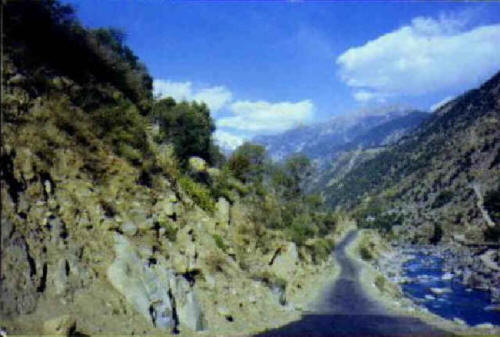
The Khyber Pass
A tourist advertisement
I saw in a national newspaper, indicated the contrast between the
magnificent upland scenery and the troubled political situation. It
welcomed tourists to a “Shangri-la” type resort in the mountain area of
the far north-east. The advert extolled the resort for its beauty and
tranquility, and elaborated on the feelings of peace and one-ness with
nature that visitors would experience. At the foot of the advertisement
was a small-print disclaimer that informed those who read it, that the
tour operators would take no responsibility for any hurt, injury, loss
of life or property that visitors might suffer due to earthquakes,
landslides, wars, terrorist attacks, kidnapping or robbery!
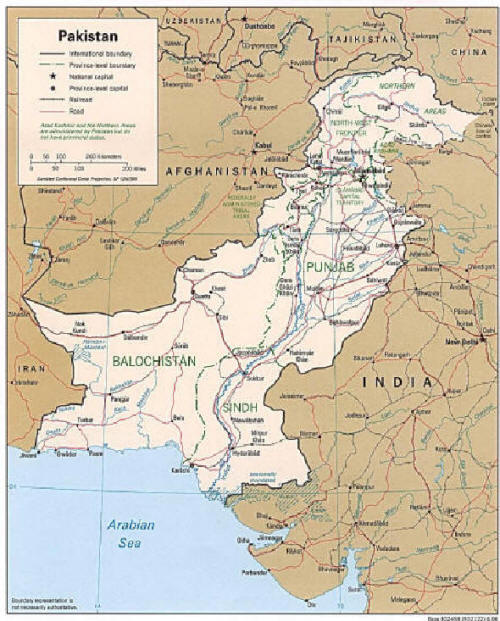
map of Pakistan
A severe earthquake hit
the region north and east of Islamabad, Pakistan on 8th
October, 2005, and also impacted on towns and villages in nearby
Afghanistan, Kashmir, and India. The death toll rose to a horrific
80,000 persons, with tens of thousands more injured and left homeless.
The country had suffered a similar strong earthquake in 1935. India was
struck more recently in January 2001 when over 20,000 persons were
killed. Iran lost 40,000 persons from a powerful quake in 1990. We
have short memories for these tragic events. The past hundred years
have witnessed over 20 major quakes, - an average of one every 5 years.
China alone has lost nearly a million of its people to seismic events
and related disasters the past century.
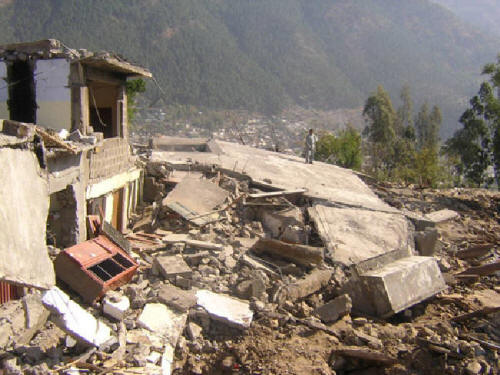
Above : effects of the earthquake of 8
October 2005
Karachi is a thriving
seaport city with an industrious people. It faces the Arabian Sea, 200
miles north-west of the Indian border, and over 300 miles east of Iran
on the Baluchistan coast. There is a thriving fishery for shrimp,
mackerel, shark, tuna, and various demersal fishes, operated from the
harbour, though the lack of clean water, ice and hygienic handling
facilities, greatly reduce the benefits of the seafood produced. Poor
water quality and inadequate hygiene are a national problem and the
contamination of vegetables grown in waste water as well as in food
handling, results in the occurrence of some wicked forms of bacteria
that can cause serious food poisoning. The Pakistan Medical Research
Council recognizes that polluted water is the root cause of a large
proportion of diseases, and that gastro-enteritis is a leading cause of
death. So visitors have to be careful. A considerable amount of
smuggling goes on along the Baluchi coast, and the fishing fleet has at
times been used to launder money from the narcotic drug business. A
former neighbour of mine, John Crockett, did some excellent pioneering
work on the fishery there in the 1980’s when working for a U.N. agency.
He was later awarded an MBE for his work.
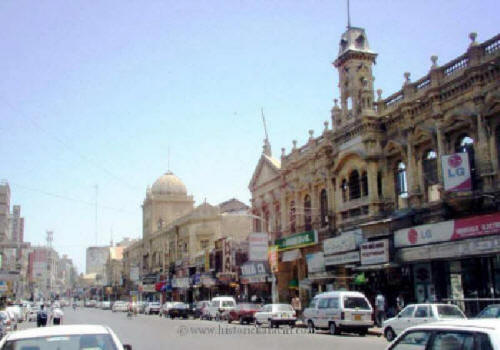
Karachi
The huge country of
India, with its one billion inhabitants, now the second largest nation
in the world, is an enormous sub-continent of rich culture and
creativity. None who have lived or served there have failed to be
impressed or to learn much about life from its lovely people. It was
the jewel in the crown of the British Raj, and a source of much wealth
for its merchants from the days of Robert Clive and the East India
Company in the mid-18th century. It has produced men and
women of wisdom and insight and influence, from Siddhartha Gautama (the
Buddha) in the fifth century BC, to Mahatma Ghandi in the twentieth.
Yet it is a land that, like China, faces enormous tasks in providing
food and water and shelter and employment for its teeming millions.
I served with a number
of excellent Indian officers including John Kurien from Kerala, who
worked all his life to achieve a measure of economic liberation for the
poor fishers of India’s south-west coast. I also knew Davidson Thomas
of Madras when he served with FAO. We tended to get each other’s mail
when out paths crossed, due to the similarity of our names. Once I
asked Davidson how he acquired his second name which was not Indian. He
expressed surprise that I did not know the connection between Thomas the
disciple of Jesus, and his home town of Madras. Apparently the apostle,
once famous for his doubts, crossed the Indian sub-continent with the
gospel, and was martyred in that city. Later, on my visit to the Bay of
Bengal programme headquarters in Madras, I took time to climb up
St.Thomas’s Mount outside the city, to the traditional site of the
martyr’s death. It struck me as strangely significant that the follower
of Jesus who was the last of the twelve to be convinced of the
resurrection, went farther with the message of the risen Christ than any
of the others.
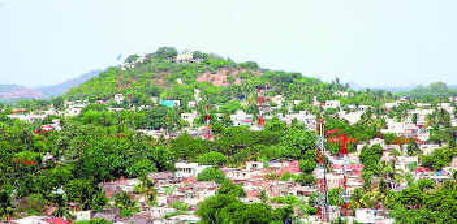
St Thomas’s Mount, Madras
The extreme poverty one
sees in much of India, affected me as it does most visitors. One
wonders at the spirit and resilience of people who have so little of
this world’s goods. And yet, to spend time in a village of grass huts
and old worn-out dugout canoes, and gain first-hand a glimpse of their
feelings and aspirations, is salutary. I admired the local NGOs who
worked with them. Young university graduates who could have earned a
decent salary in the city had decided instead to commit themselves to
serving the poor communities. They taught by means of play, music and
drama, with dramatic effect. I had read of similar powerful results
from the Brazilian, Paulo Freire’s radical work in the education field
in Latin America. The people responded to presentations that touched on
their situation and the injustices they felt. One sketch was so
realistic, when a uniformed “policeman” appeared at a critical point,
blowing his whistle and attempting to arrest an actor, - one local woman
screamed and ran to hide from him, - unaware he was part of the act!
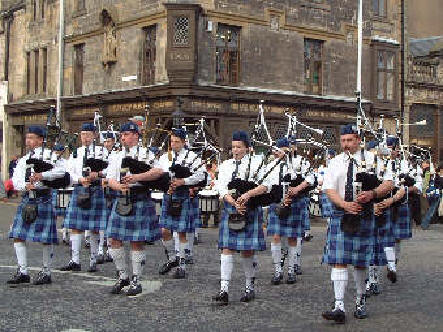
Pipe band of St Andrew’s School Madras
A retired wealthy tea
planter, Boyd Anderson, settled in our town in the 1930’s, and bought
one of the large houses overlooking the golf course. He was generous to
the town and the golf club, and donated the pleasant Milbuies estate
south of Elgin, to the people of the district. His large garden sloped
towards the 18th fairway. He had crocuses planted in the
shape of a map of India and Ceylon. Each spring when the flowers
blossomed, there was a resplendent reminder of the land where he made
his money. I often admired the display, never thinking that I would be
privileged to see those beautiful lands in later years.
|
EMPIRE AND COLONIALISM
The
rationale behind the British Empire and its assumption of a
global authority and the right to invade and possess foreign
lands, has been credited to a Scottish military engineer of
remarkable learning and ability. Charles Pasley in his Essay
on the Military Policy and Institutions of the British Empire,
argued that for Britain, true national security rested on
policy and power – especially military power. He envisaged
possession of large overseas colonies that would provide sailors
and soldiers to serve Britain’s navy and army. He did doubt
that much war was inevitable in consequence, but reckoned no
nation could resist the forces of the British Empire if the
country “thought offensively, and acted vigorously”. Though
written 200 years ago, Pasley’s treatise would delight the
present U.S. President and his Secretaries of State and of
Defence.
It
has been argued that the regimes displaced by the colonial
governments, were mostly lacking in justice or genuine concern
for their people, and in some cases condoned slavery,
subjugation of women, human sacrifice, and cruel forms of
punishment. All that is true to varying degrees in the past,
for a number of the territories occupied by Britain. And
despite its ruthlessness in suppressing opposition, colonial
rule adhered to a recognised system of justice, and established
orderly administrations. The colonial machine reached its peak
in India where a remarkably small cadre of civil servants and
soldiers, governed that immense, diverse and populous land.
But
we have to be honest, and remember that Britain for many years
condoned and practiced slavery. And in its efforts to control
China, it was only too ready to engage in the illegal opium
trade (with the active support of James Matheson and William
Jardine who established the Jardine Matheson Company that has
prospered on the wealth of Hong Kong). The treatment of
Afrikaaner farmers in a territory they had more right to than
Britain, is a blot on our nation’s record. More recently we
have seen a whole population removed from their Indian Ocean
islands of Diego Garcia, with scant compensation, to make room
for an American military base. So our record as colonialists,
while perhaps better than that of others, is still far from
blameless. |
Sri Lanka
And now
to Sri Lanka which I first visited in 1983, shortly after one of the
worst of the Tamil – Sinhalese conflicts in Colombo.
Travelling through the
city on minicabs, I drove past row after row of burnt out shops and
houses. Every day the local press carried jingoistic speeches by
Sinhalese politicians, exulting in their new-found aggressiveness, and
daring India to respond in kind. The violence had occurred a few short
weeks before my arrival. Later some Tamil friends and those of mixed
marriage, told of the night of mob law when drunken gangs were led by
militant Buddhist priests, who urged them to burn Tamils out of house
and home. Distraught relatives told of family members crying to them on
the telephone while the crowds outside smashed windows and set fire to
the building. Tamil families who were Christian in their religious
affiliation received the same treatment as the Hindu members of their
race.
The Tamil – Sinhalese
problems go back a thousand years, to when Tamils from India settled in
the north and east of the island. Later, British tea planters were to
bring more Indian Tamils to work on their estates since they represented
cheaper and more pliable labour. For a brief while after independence
from Britain, Tamil enjoyed equal status with Sinhalese as a national
language, but this was to change in a series of measures to placate
Sinhalese nationalism. The measures were introduced by the Bandaranaike
family who presented themselves politically as socialists, but who were
described to me by Sri Lankans as merely “opportunistic socialists”.
Their real political philosophy, and the source of their political
power, lay in their promotion and protection of militant Buddhism
(surely a contradiction in terms), and in their intense dislike of the
Tamil people.
Like the troubles of
Northern Ireland, Sri Lanka’s conflicts occurred between people of
similar religious faiths, - Hindu and Bhuddist. These two Indian
religions come from the same cradle, Bhuddism being a later development
of Hindu thought. But as with Sunni and Shiite Moslems, the differences
sometimes bring their followers into conflict. Ethnically, the peoples
are slightly different, but a foreigner could not tell one from the
other when passing them on the road. However, the problem should be
seen in perspective. As in Northern Ireland, the vast majority of both
populations live in harmony. I was delighted to join thousands of Sri
Lankans, - Buddhist, Hindu, Christian and Moslem, in November 2001, who
linked hands along the city streets in a demonstration of their support
for peace and reconciliation. But it only takes a few troublemakers on
either side to stir up strife, and when they are supported overtly or
covertly by politicians, the results are tragic.
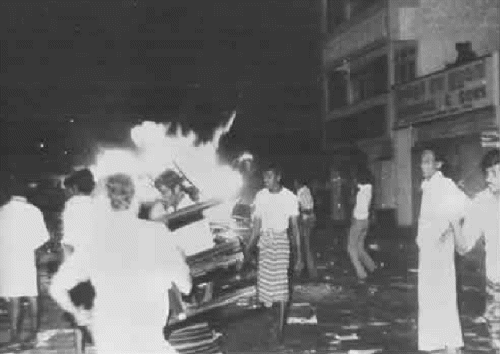
anti-Tamil riots in Colombo, July 1983.
Over 1,000 Tamils were murdered and scores of houses and shops
destroyed. My first visit to the country was just days after these
events.

map of Sri Lanka
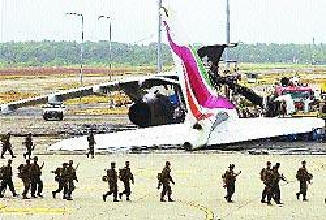
My fourth visit was a week after the
destruction of 16 aircraft at Colombo airport on 24th July
2001 by Tamil rebels.
If my first visit took
place just after civil strife in Colombo, my fourth one was to occur on
the day Colombo airport was attacked with the loss of most of the Air
Lanka fleet of passenger aircraft. I received a call at 3.00 am, just
one hour prior to my departure, advising me to await further notice
before travelling. When I eventually got to Sri Lanka a week later, the
scene at the airport was still one of devastation. The country was then
hit seriously by an almost complete shut-down of the tourist trade which
was the main foreign currency earner for he country. It took the
election of an opposition party to re-activate the peace process and
facilitate a return of tourists in large numbers. However, the party
of President Chandrika Bandaranaike regained power in the following
election, and the peace process has been at a stalemate since then. On
the one hand, militant Buddhist priests seem intent on reviving the
conflict. On the other, those countries that pledged huge amounts of
support to relieve the suffering caused by the tsunami disaster, have
insisted that the President mend fences with the Tamil community, and
permit foreign aid to reach the north and east of the country.
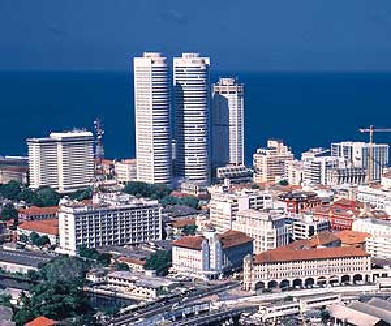
Colombo city
It is all so tragic
since the people of the beautiful island of Sri Lanka have so much to
offer the world. They are artistic, industrious, pleasant and
hospitable, - and that includes all of the ethnic groups. The land
itself ranges from pristine coral beaches up to the magnificent highland
tea-growing areas where it can be distinctly chilly. The food is rich
and ample, if rather dominated by fierce curries that are too hot for
most European palates. Although I witnessed the effects of the
violence, I myself was treated kindly by all ethnic groups in all my
dealings there, and in my travels through the country.
Sri Lanka, like India,
has an ancient history that goes back two or three millenniums. The
port of Galle on the south-west tip of the island was known to Arab and
Portuguese traders for centuries. Some scholars believe that it may
have been the biblical “Tarshish”, that is mentioned in
the book of Jonah, and to which the recalcitrant prophet Jonah
attempted to abscond. Some Sri Lankans even believe that the country
was the site of the original Garden of Eden. This idea is incorporated
in a number of national myths and legends.
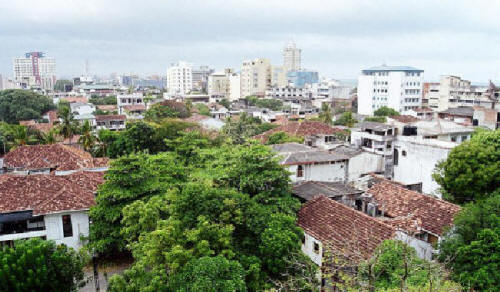
Apart from tea and
gems, the country has huge resources of forests and its seas are replete
with fish of all kinds. The fishing fleet is unique. Boats are small
by any standards, yet these little 30 and 40 foot vessels fish in every
part of the Indian ocean, - off the coast of Somalia at times, and as
far south as the Australian EEZ. They work for shrimp, reef fish,
lobster, crab, tuna, shark, and squid. A favourite midnight meal in Sri
Lanka, is curried crab, which I was often invited to share.
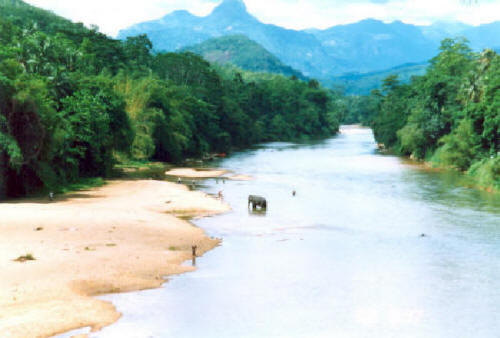
Elephants crossing a river just below the
site used for the film Bridge over the River Kwai. That bridge
is in Burma, but the film was made in Sri Lanka.
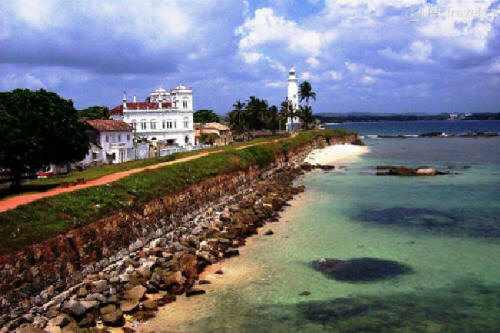
the southern port of Galle
I must relate a tale
from the city of Kandy, that amusingly illustrates the silliness of our
obsession with race and ethnic origins. A doctor I came to know on a
return visit he made to Sri Lanka, from Oregon USA where he practiced,
told of the boarding school he attended in Kandy as a young boy. Shiva
Beckenridge was the product of a mixed marriage, Tamil / Sinhalese. At
the school on occasions, the teacher would make the pupils stand up
according to their race. So, - “would all the Singhalese pupils
please stand”, and “now, would all the Tamil pupils stand”, and then,
“would all the Burgher pupils stand”. (Burghers were descendants of
mixed Dutch-Ceylonese people). Because of his origins Shiva was
perplexed and did not know what to do. A nervous wee boy, he decided to
side with the majority and so stood up with them. But by the time he
got to high school, he thought, “this is wrong”. So when the
Master asked the same questions one day, he remained seated. The Master
roared, “Shiva – why are you still sitting ? What race do you belong
to ?” Young Beckenridge looked up and responded, “the human
race, sir” ! Below :
Kandy town in the tea planting mountain area
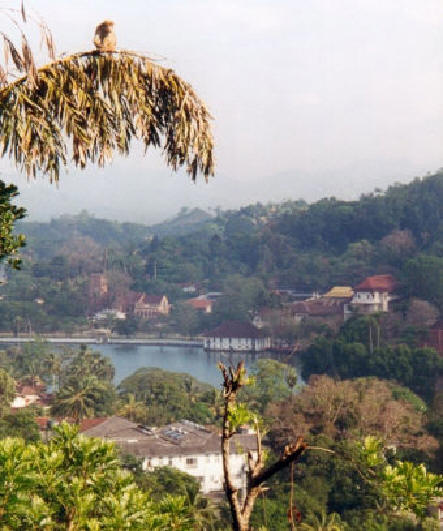
During the early days
of self-government, the country embarked on a rural development project
that for it was as important as the Tennessee Valley development was for
the USA in the time of President Roosevelt. The Mahaweli Project
involved huge reservoirs of water and related hydro-power and irrigation
schemes in the east-central part of the country. Heading this enormous
project was Lalith Godamunne who was later to be a Director of the World
Food Programme. Some years later he described the Mahaweli undertaking
to me in detail, relating what was most successful, what had limited
impact, and which aspects involved the most difficulty.
Godamunne was appointed
as my counterpart officer when I served on an Asian Bank project
designed to address the problems of coastal conservation and marine
fisheries in Sri Lanka. The conservation aspects related chiefly to
severe erosion of beaches on the west coast, and related silting of
parts of the south shore, and to the demand for sand and gravel by the
national construction industry that led to over extraction of material
from the beaches and the sea bed. He was an excellent colleague,
judicious, perceptive, and ever ready with a proposed solution to each
difficulty that arose. Like most Sri Lankans he loved his cricket, and
would regularly steal an hour when possible, to watch a test match. The
game had been a mystery to me till then. (There was little cricket
played in Scotland.) But Lalit patiently instructed me in its finer
points.
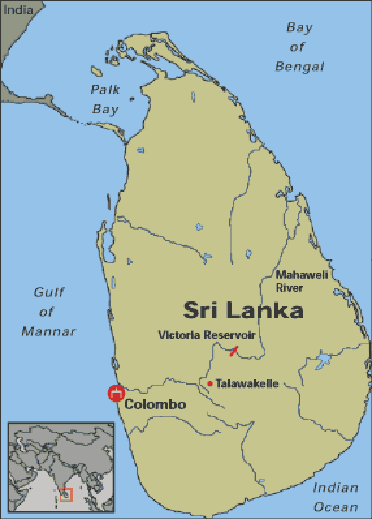
Mahaweli river system which was the basis
of the Mahaweli development plan, based on the successful Tennessee
Valley Authority established by Roosevelt to counter the great
depression. I worked with Mahaweli’s first Director, Lalith Godamunne,
some years later.
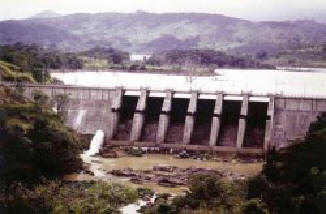
One of the Mahaweli programme dams
On a later project I
worked with Ari Kananggara, a successful local businessman who took on
direction of a fisheries authority, more out of a sense of obligation,
since he had assisted Prime Minister Ranil Wickremasinghe in his efforts
to put together a coalition that eventually won the 2001 election. Ari
was typical of the best of the Sri Lankan private sector, - diligent,
attentive to detail, decisive, yet taking time to fully grasp all of the
factors in play, and to identify the key issues that had to be resolved.
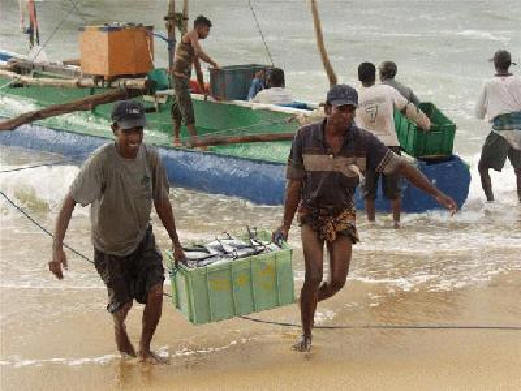
Above ; Fishermen of Sri Lanka
The previous
administration had politicized the civil service to a degree I had not
witnessed outside of the few communist or totalitarian states I had
worked in. Each government organization had a political commissar. I
describe them as such, though they went under the title of consultants
or advisers to the Director or Chairman. They were nasty officials, and
secure in their positions, they would act in arrogant, brutal and
bullying fashion to staff members. I guess all this was a reflection of
the way the Bandaranaike administrations looked up to and tried to
emulate, the systems in China and the Soviet Union. Even drivers of
official vehicles were hired to fill a double role. We were warned in
confidence not to speak critically of the government when traveling in
an official car. I heard of one official driver who walked into a
reception to help himself to the food and was told by an unsuspecting
junior official that the drivers’ food was on another table. The
official was sacked next day. A huge corporate sigh of relief went up
throughout the country when they all lost their jobs after the election
of December 2001. But they were probably put back in place after
President Chandrika Bandaranaike Kumaratunga’s party regained power in
2004. Now she has had to retire and her Prime Minister has become
President.
Sri Lankans are a
cultured people, and one could find excellent musicians performing at
numerous locations throughout the city of Colombo. There are also a
number of choirs that would vie with any in Europe. We loved the Merry
Anne singers, - a classic youth choir that would compare with the former
Kirkintilloch junior choir in Scotland. They were led by the talented
Mary Anne David, a Sri Lankan woman of Australian descent. In one of
those odd coincidences that happen abroad we discovered that her husband
Joseph had been educated many years before in Madras, India under a
Scots missionary teacher, Professor MacNicol, whose son became a leading
surgeon in Edinburgh. Dr Malcolm MacNicol had successfully operated on
our youngest daughter when she was diagnosed with congenital dislocation
of both hips at the age of eighteen months. One of our older daughters
later became manager of the theatre department of Murrayfield hospital
where the gifted MacNicol performed many operations.
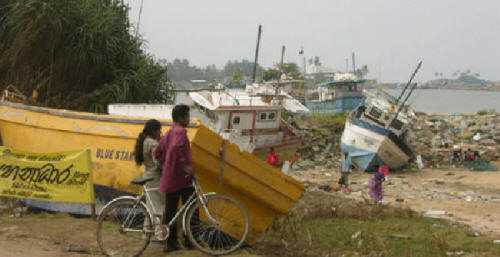
Damage caused by the tsunami of December
2004
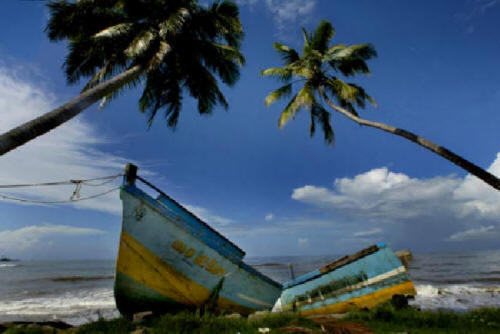
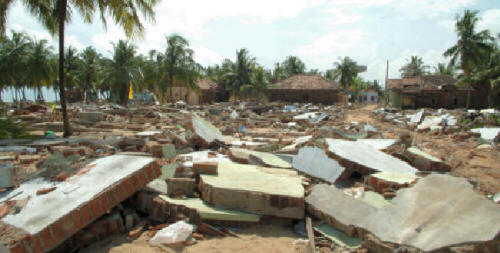
An unprecedented
disaster struck Sri Lanka on Boxing Day 2004 when a tsunami tidal wave
wreaked havoc on its coast from the Tamil north-west to the Singhalese
south coast and southern east coast. Over 40,000 persons were killed,
and hundreds of thousands were made homeless. The coastal
infrastructure, fishing fleets and countless coastal villages were
destroyed. The tear-shaped island experienced sorrow upon sorrow, its
pristine beaches and lagoons turned into graveyards for numberless
innocent persons who were going about their normal business that Sunday
when the ocean bed earthquake created a 2,000 kilometre long wave of
immense proportions. The work of restoration is now under way,
supported by a remarkable global response of generosity and sympathy.
But coastal life in the beautiful island will never be the same again.
The year 2006 saw a resumption of hostilities between the Tamil
liberation movement and the Sinhalese dominated government, with both
parties becoming increasingly beligerant, polarised and aggressive. As
elsewhere in this troubled world, hard line attitudes produce similar
responses and the fragile dove of peace is crushed between the opposing
forces, whether they be Israelis and Palestinians, Turks and Kurds,
Russians and Chechnyans, or Tamils and Sinhalese. The ‘eye for an eye,
and tooth for a tooth’ policy leaves everyone blind and toothless in the
long run, as Martin Luther King used to affirm. We need leaders who are
big enough and brave enough to break that sad cycle of violence and
begin the serious and painful process of reconciliation; - men like
Nelson Mandela and Desmond Tutu, or like Anwar Sadat and Yitzhak Rabin,
who both paid for their majestic actions by the ultimate sacrifice of
their lives. Such men are human and less than perfect, but in the
crucial task of bringing an end to war and bloodshed, they have
displayed exceptional vision and courage. Blessed are the
Peacemakers. |

